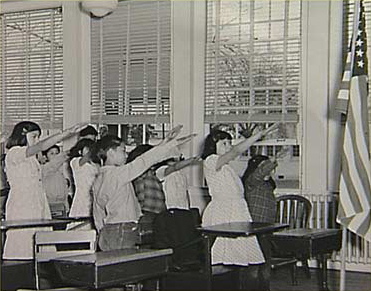We’ve all recited: “Eye pleasure legion stew the flag, an tooda republic for …” with maybe a glimmering of what it meant. The ideas are too complex for the school age children to parse. It is a mantra intended to imprint kids so that later they don’t question the ideas because they feel that they’ve always held them.
When it was first cooked up after the painful division and reunion of our nation, the Original Recipe taught to all school children was:
I pledge allegiance to my flag,
and to the Republic for which it stands.
One nation indivisible,
with liberty and justice for all.
And while you recited it, you stood proudly with your right hand elevated and pointing toward the flag, thus:

In the early 20th century there was so much immigration that Congress feared that children would not know which was “my flag”. So they changed it to “the flag of the United States of America” to reduce such confusion. I’d have thought that replacing “One nation” rather than “my flag” would have been more effective
And in the 1940’s the patriotic pose started to seem a little too reactionary, and was changed to the hand on the chest. One didn’t want to seem too blindly patriotic, I guess.
Another decade later, when Stalinism was the species of Communism practiced by our only serious nuclear rival, labels like “atheist” and “communist” were political death in America. In order for Congressmen to avoid the appearance of sympathy to any such ideas, they were goaded to add another clause to the pledge: “Under God”. It makes the line more awkward, but de facto successfully declares the U.S. to be a nation subordinate to a deity, not one of secular rule.
They had already stamped a comparable phrase on our money in the mid-20th century for similar reasons, as I discussed here.
One of the fearful campaign rants about what Obama will do to our nation is that he, as president, would not veto a bill to take the superfluous cold war theism clause back out of this childhood oath.
Let’s make their fears a reality, shall we?



Your opening brought back memories. As a student, I was often forced to say the pledge of allegiance (as a 7, 8 and 9 year old) before every school day. I can guarantee you that none of the students had any idea about what the pledge meant. As you suggest, we didn't even understand the words. We just stood up, hands over our breasts and made noises.
What year was this school picture really taken? The source said 1892. And we can see that the flag has staggered rows of stars.
Here are all the U.S. flags of the era (mouse over for year):
So the flag must be between 1890 and 1912. The ceiling fixture was probably a fan.
And the issue stays alive: Making children say the pledge of allegiance over and over is "teaching them history."
Nice video echoes my opinion:
Here is and article printed on the anniversary of the origin of this oath (12/22/2013) with even more details: The peculiar history of the Pledge of Allegiance